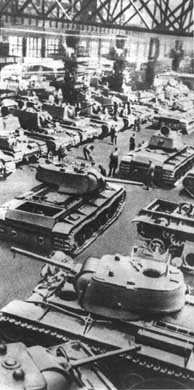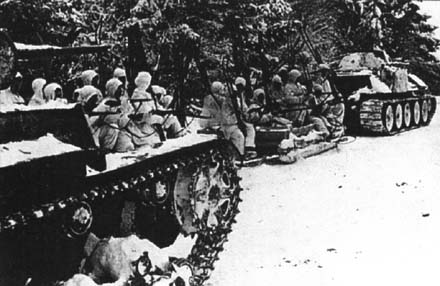Russian TANKS
Introduction
In the '20 Russians developed a cooperation plan with the
German military for designing armored vehicles. Because this
cooperation was not completely satisfully they begin to buy and
test the anglo-saxon models: American and British expecially;
french were rejected because of the conservative operational
approach of the French Army about armored warfare. Vickers,
Carden-Lloyd, but expecially the american Christies' were bought
and then examinated and developed in Russia. Pre-war Russian
doctrine required the mobile forces to be splitted in
operation-oriented formations, as Guderian wrote in its
"Achtung, Panzer!" (1937):
[..] Russians try to put in practice
priciples of the total and simultaneous destruction of
the enemy front by using their mechanized forces' attack
organization. For this objective they distinguish three
different formation types:
- NPP - infantry close support;
- DPP - infantry long range support;
- DD - long range forces.
NPP type forces are organized around the 6 tons
Vickers-Armstrong-Ruskii AT 26, armed with a 59mm gun
[the Russian T-26 was equipped with 45mm L46 AT gun] and
two MGs and with an armor protection effective against
light armor piercing ammo. Exactly 26 tanks of this type
cover the action of other 35 tanks equipped with MG, the
Vickers-Carden Lloyd-Russkii T-27, which are less armored
but have have good capabilities about overrunning
obstacles. The complements of a NPP force are filled with
20 BA-27 light tanks, with 37mm guns plus some tiny
'Banierford' tanks. The 'infantry close support'
designation effectively resumes the task of this unit
type which therefore require, to succeed, more powerful
tanks capable of crushing the most solid strongholds and
eliminating artillery and AT defences. This type of
mission is assigned to the DPP-type forces.
These formations for 'infantry long range
support" are equipped with heavy assault tanks (M I
and M II types) [??? perhaps T-28 and T-35]; these have a
main armament based on a 75mm gun [i think 76,2mm],
flanked by one or two minor caliber AT guns and some MGs.
DPPs also have at their disposals a light armored
component, equipped with the 6 tons
Vickers-Armstrong-Russkii and Vickers-Carden-Lloyd
anphibious tanks.
Once the DPP and NPP forces have been able to
breaktrough the enemy front-line and fix on their places
the defenders, DD type forces are to exploit the success
and advance the command centers, reserves, communication
lines and rear installations; during this phase the DDs
count on massive air support. The result of this mission
is realizable by disposal of a particularly fast tank the
Russians have got by adapting an american project [see
the BT light tank section]. The Christie-Russkii 34 tank
[i think the BT-5] is armed with a 47mm gun [instead it
was a 45mm] and a MG, its armor is thin but it has a 400
Km autonomy, a 110Km/h wheeled speed and a 60Km/h tracked
speed. To summarize, the Christie-Russkii is a
particularly well designed vehicle that has given a good
proval of itself. Over these tanks, DD forces deploy a
remarkable quantity of armored recon vehicles and some
versions of the six-wheels Ford anphibious mean [???]
armed with 37mm gun and MGs.
All summed, the Russian armored forces
organization gets its validity: to depth operate against
the enemy they have fast tanks with great autonomy; the
facing of enemy tanks and artillery - heavy or anti-tank
- on the main battlefield can be assolved by heavy
armored and armed tanks; the infantry combat area
'reclamation' can take advantage from the presence of
MGs-armed light tanks. Thereafter, three mission
type-classification requires a plethora of ad-hoc
vehicles with all the implied disadvantages this takes.
[...]
|
Inernal situation
 In 1935 over thirty (30) tank-oriented
industrial plants existed and with the 2nd quinquennal plan the
tank reached the amazing number of 20,000 vehicles. But such a
force based on the principles of technocratic efficiency
stimulated Stalin's paranoy. Armored warfare doctrines were
banded as reactionaries and during the purges the very bulk of
Red Army officiers corps along with the technicians was executed
or reclused in Siberia: a loss that will prove decisive in
Germans' early victories in 1941. Nevertheless the tank
development project proceeded because of the international
situation: new prototypes were tested in Spain and in the 1939-40
winter war against Finland. They evolved in the well-known and
German feared/admired T-34 and KV tanks.
In 1935 over thirty (30) tank-oriented
industrial plants existed and with the 2nd quinquennal plan the
tank reached the amazing number of 20,000 vehicles. But such a
force based on the principles of technocratic efficiency
stimulated Stalin's paranoy. Armored warfare doctrines were
banded as reactionaries and during the purges the very bulk of
Red Army officiers corps along with the technicians was executed
or reclused in Siberia: a loss that will prove decisive in
Germans' early victories in 1941. Nevertheless the tank
development project proceeded because of the international
situation: new prototypes were tested in Spain and in the 1939-40
winter war against Finland. They evolved in the well-known and
German feared/admired T-34 and KV tanks.
In 1934 there were two mechanaized corps with 500 tanks each,
each corps composed by two o three DD brigades along with an
auxiliary motorized infantry brigade, an artillery regiment; out
of them there were six more indipendent DD brigades with 90 tanks
each.
In 1939, despite of Zhukov's successes during the "secret
war" against the japaneses, in the Kalkin Gol area, the
mechanaized corps were disbanded and their units dispersed
between the major infantry units.
After the huge 1941 losses the Russian took their greater
armored unit to a brigade level: two or three armored battalions
- fifty tanks in all - grouped in eterogenous dormations, with a
motorized infantry battalion and anti-tank and anti-aircraft
artillery elements. These armored brigades were easier leadered
by the inexperted soviet commanders, although they were
prematurely defeated when launched in the 1942 spring's
counter-attacks (trying to delay "operation Blau", the
German offensive in the southern sector).
After then the tank brigades were re-organized on a more
homogeneous base, with 53 modern T-34s and T-70s in each
battalion, while the autonomous battalions were doubled in their
organics up a regimental level with 39 light and medium tanks.
The heavy tanks were concentrated in special regiments with 21
tanks each.
Moreover the major formation were re-organized: the tank corps
with three armored brigades and one infantry brigades and the
mechanaized corps with three motorized infantry brigades (each
with its own tank regiment). Each corps had 180-200 tanks, along
with recon, moto, engineer, transmission and bridging troops plus
AT and AA units. Two armored corps and one mechanaized corps
formed a Tank Army.
Out of this, it must be said that afte the 1941 the industrial
manufacture was oriented towards the succesful T-34 and KV tanks:
the older T-26, T-28, T-35 and various BT light tanks were
confirmed to be ineffective becasue of their armor and weaponry
and their production was cancelled. This was an example of the
pragmatic Russian thought: in last years of war, while the
Soviets put on the the field many thousand of tank of very
homogenous type, in greatest majority T-34, the Germans were
still fighting with many several models such as Panzer III and IV
derivatives, Panthers, Pz-38(t), Tiger I and II, Elefants, all of
them sharing very few (if none ...) parts and each requiring
custom productions. While the Soviets could manufacture thousand
of tanks due to their uniformed designs and maintain in
efficiency their tank forces providing the spare parts they
needed, Germans were in difficult doing this, for both higher
decisions and desperate need of any type armored vehicles.
In 1943 the Self propelled artillery regiments were formed,
the SU regiments. They were aggregated to the major infantry or
tank units, for a close and immediate fire support. They were
often mixed with armored brigades or tank regiments to form the
SU mixed groups.
 |
Infantry transport on tanks (and
other various improvvised means) was
an official principle in Russian mobile warfare doctrine.
|
In 1944 the soviet standard armored brigade growed up to 65
tanks where the independent armored regiments up to 43, normally
all T-34. The heavy tank brigades got 23 IS tanks. With two heavy
regiments and two SU regiments aggregated, the tank or
mechanaized corps can count on circa 300 between tanks and SP
pieces.
By German surrender the soviets had 302 armored or mechanaized
brigades, grouped in 25 tank corps, 13 mechanaized corps, sixty
indipendent brigades (armored or motorized), 180 autonomous
regiments plus 150 SP-artillery regiments. A huge production
supplied such a mighty force: over 87,200 tanks and over 25,300
SUs were built in the 1940-45 period. Along them Russia got 4,260
tanks from Great Britain, 5,258 form U.S.A. and 1,188 from
Canada: a contribute that, nevertheless being technologically
inferior to the soviet mean, was vital during the major battle
losses period.
Document: German 203º
Panzerregiment's experience while fighting the KV-1s and T-34s
(courtesy of Dr. Leo Niehorster)

|
This page is online thanks
to Geocities, the largest Web Community! Get your own free page at Geocities!!!
|
 In 1935 over thirty (30) tank-oriented
industrial plants existed and with the 2nd quinquennal plan the
tank reached the amazing number of 20,000 vehicles. But such a
force based on the principles of technocratic efficiency
stimulated Stalin's paranoy. Armored warfare doctrines were
banded as reactionaries and during the purges the very bulk of
Red Army officiers corps along with the technicians was executed
or reclused in Siberia: a loss that will prove decisive in
Germans' early victories in 1941. Nevertheless the tank
development project proceeded because of the international
situation: new prototypes were tested in Spain and in the 1939-40
winter war against Finland. They evolved in the well-known and
German feared/admired T-34 and KV tanks.
In 1935 over thirty (30) tank-oriented
industrial plants existed and with the 2nd quinquennal plan the
tank reached the amazing number of 20,000 vehicles. But such a
force based on the principles of technocratic efficiency
stimulated Stalin's paranoy. Armored warfare doctrines were
banded as reactionaries and during the purges the very bulk of
Red Army officiers corps along with the technicians was executed
or reclused in Siberia: a loss that will prove decisive in
Germans' early victories in 1941. Nevertheless the tank
development project proceeded because of the international
situation: new prototypes were tested in Spain and in the 1939-40
winter war against Finland. They evolved in the well-known and
German feared/admired T-34 and KV tanks.
